Contact us
LED Pixel Pitch Guide: Best Viewing Distance & Resolution
Investing in a digital display is one of the largest capital expenses for any business. Yet, we see a recurring mistake in the B2B market: companies overspending on “ultra-fine” resolutions they don’t actually need, or underspending on displays that look pixelated to their audience. Imagine presenting your quarterly report on a blurry screen, or conversely, realizing you blew 30% of your budget on resolution your audience literally can’t see. Pixel pitch isn’t just a spec; it’s the difference between a visual disaster and a smart investment. The secret to balancing budget and visual performance lies in one technical specification: LED pixel pitch.
Whether you are planning a corporate boardroom, a retail storefront, or a house of worship, understanding the relationship between LED wall pixel pitch and viewing distance is the key to a high ROI. In this comprehensive guide, UnifyLED breaks down everything you need to know to make the right decision.
Table of Contents
1. What Is Pixel Pitch in LED Display?
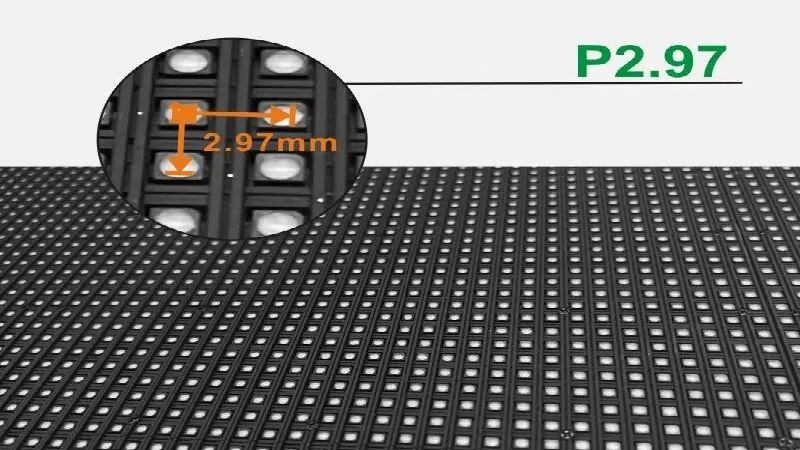

Let’s start with the definition. What is pixel pitch in led display?
Pixel pitch (also referred to as dot pitch) is the physical distance, measured in millimeters, from the center of one LED cluster (pixel) to the center of the next adjacent pixel. You will typically see this listed with a “P” followed by a number.
P1.2 = 1.2mm between pixels.
P3.9 = 3.9mm between pixels.
P10 = 10mm between pixels.
The Golden Rule: A smaller LED screen pixel pitch means higher pixel density and higher resolution, but it comes at a significantly higher cost. Conversely, a larger pitch means lower resolution but is more cost-effective.
2. Why Pixel Pitch Matters for Your Project
Choosing the correct spec isn’t just about technical vanity; it’s about the viewer’s experience. The LED panel pixel pitch directly correlates to the minimum viewing distance.
If the pitch is too large for the viewing distance, your audience will see the individual black gaps between the lights (a distracting “screen door effect”). If the pitch is unnecessarily small for a far viewing distance, you are paying for fine pixel pitch LED technology that the human eye literally cannot appreciate.
Resolution vs. Size
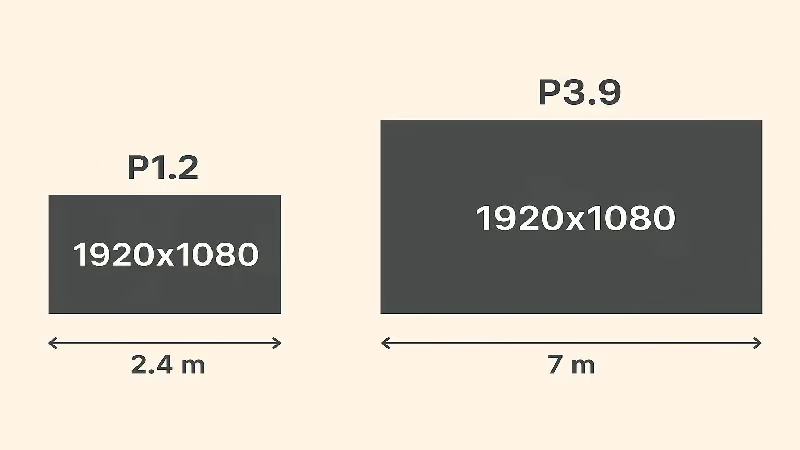
Your LED video wall pixel pitch also dictates the overall resolution of the screen.
To achieve Full HD (1920×1080) on a P1.2 wall, the screen only needs to be 2.4 meters wide.
To achieve Full HD on a P3.9 LED wall, the screen must be over 7 meters wide.
3. The Math: LED Pixel Pitch Viewing Distance
This is the most critical section for project managers. How do you calculate the “sweet spot”? There isn’t just one answer; there are two standards for LED wall pixel pitch viewing distance.
1. Minimum Viewing Distance
This is the distance where the image becomes coherent, though you might still see some pixelation if you look closely.
Formula: Pixel Pitch (mm) × 1 = Minimum Viewing Distance (Meters)
Example: A P2.5 screen has a minimum viewing distance of 2.5 meters.
2. Optimal Viewing Distance
This is the distance where the human eye can no longer distinguish individual pixels, resulting in a smooth, continuous image. For luxury retail or boardrooms, aim for this metric.
Formula: Pixel Pitch (mm) × 2.5 (to 3) = Optimal Viewing Distance (Meters)
Example: A P2.5 screen looks perfect from 7.5 meters away.
4. LED Pixel Pitch Calculator (Quick Reference Chart)
Instead of doing the math manually with a LED wall pixel pitch calculator, use our UnifyLED reference chart below to match your venue size:
Pixel Pitch (Model) | Minimum Viewing Distance | Optimal “Retina” Distance | Best Application Scenario |
P0.9 – P1.2 | 1m – 1.2m | 3m+ | Control Rooms, High-End Boardrooms |
P1.5 – P1.9 | 1.5m – 1.9m | 4.5m+ | Retail Indoors, TV Studios |
P2.5 – P3 | 2.5m – 3m | 7.5m+ | Churches, Conference Halls |
P3.9 – P4.8 | 4m – 5m | 12m+ | Rental Events, Large Indoor Venues |
P6 – P10 | 6m – 10m | 20m+ | Outdoor Billboards, Stadiums |
Don’t trust your math? Let our engineers run a precise CAD simulation for your venue—free of charge.
5. Selecting the Best Pixel Pitch for LED Wall Applications



Different industries have different requirements. Here is our expert breakdown on finding the best pixel pitch for led wall installations in your specific sector.
Indoor Corporate & Control Rooms
For environments where viewers are seated close to the screen (2-5 meters) and displaying complex data (Excel sheets, blueprints), you need fine pixel pitch LED solutions. We recommend P0.9 to P1.5. These ensure that text is crisp and readable without eye strain.
Events, Stages, and Houses of Worship
In these scenarios, the front row is usually set back at least 3 to 5 meters from the stage. Therefore, a P2.5 to P3.9 pixel pitch LED screen is the industry standard. Using a P1.5 here would be a waste of budget, as the audience is too far away to notice the difference.
Outdoor Advertising
For digital billboards viewed from highways or street plazas, the viewing distance is significant. A P6, P8, or P10 pixel pitch LED panel is ideal. These panels are designed for high brightness and long-distance visibility, rather than high pixel density.
6. The Future: Micro LED Pixel Pitch
As manufacturing technology evolves, we are entering the era of micro LED pixel pitch. This refers to pitches below P1.0 (down to P0.4). LED Packing Technologies like COB (Chip on Board) are making these ultra-fine screens more durable and contrast-rich. While currently a premium option, they are the future of high-end visualization.
7. UnifyLED Expert Tips: Avoid These Common Mistakes
Before you finalize your pixel pitch led wall order, consider these “Pro Tips” from our engineering team:
Check Your Content Source: Don’t buy a 4K LED wall if your video content is only 720p. The LED display pixel pitch should match the maximum LED screen resolution of your media player and content library.
Consider LED Screen Maintenance: Extremely small pixel pitches (like P0.9) expose thousands of tiny LEDs to potential damage. Ensure your LED screen factory (like UnifyLED) offers robust edge protection, especially for high-traffic areas.
Don’t Ignore Brightness: A pixel pitch led panel for indoor use often has lower brightness than outdoor models. Don’t just match the pitch; match the Nits (brightness) to your ambient light conditions.
8. FAQ - Common Questions About LED Screen Installation
For most indoor corporate and event applications, P2.5 to P3.9 is the standard choice, offering a perfect balance of cost and resolution. However, for boardrooms or control rooms where viewers sit within 3 meters, a fine pixel pitch LED (P1.2 to P1.8) is necessary to display crisp text and data.
Yes, generally speaking. A smaller LED screen pixel pitch (e.g., P1.5) means the pixels are packed closer together. This allows you to fit more pixels into the same physical area, resulting in higher resolution. A larger pitch (e.g., P4) has lower pixel density and requires a much larger screen size to achieve the same HD or 4K resolution.
No, smaller is not always better—it is just more expensive. If your audience is viewing the screen from a distance (e.g., 10 meters away), the human eye cannot distinguish the difference between a P1.9 and a P3.9 screen. In such cases, choosing a fine pixel pitch LED is a waste of budget. You should always match the pitch to your viewing distance.
The main difference is the viewing distance and price. A P2.6 LED wall looks clear from about 2.5 meters away, making it ideal for conference rooms or luxury retail. A P3.9 LED wall is the "workhorse" of the event industry; it looks perfect from 4 meters away and is significantly more affordable and durable for rental staging.
No. Even if the pixel pitch is suitable, indoor screens are not designed for outdoor environments. They lack the necessary brightness (Nits) to be visible under sunlight and do not have the IP65 waterproof rating required to survive rain and dust. Always choose a dedicated outdoor LED panel pixel pitch (usually P3.9 to P10) for exterior use.
9. Conclusion
Choosing the right specification is a balancing act between viewing distance, content resolution, and budget. Whether you need a LED pixel pitch viewing distance calculation for a massive stadium or a micro LED pixel pitch solution for a luxury lobby, the goal is to never pay for pixels your audience can’t see.
Ready to find the perfect fit for your project?
Contact UnifyLED Today for a free consultation and a custom CAD proposal for your venue.
10. Recommend
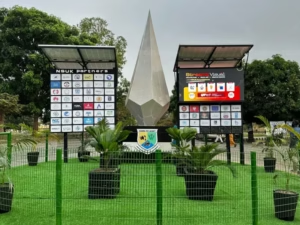
Nits vs. Lumens: Why Your Projector Can’t Beat an LED Screen?
Nits vs. Lumens: Demystifying brightness. See why LED screens beat high-lumen projectors in daylight. Learn the key difference and choose the right display.
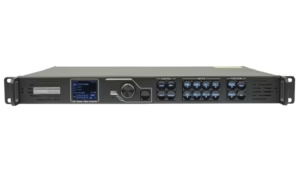
LED Video Processor Guide: Functions, Tips & Top Models
Learn how a led video processor enhances your screen. Explore functions, selection tips, and top Novastar VX vs Huidu VP recommendations.
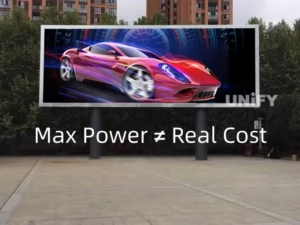
LED Display Power Consumption Guide: Watts, Amps & Cost Calculator
Master led display power consumption calculations. Learn the real difference between Max vs. Average watts and save your budget.
